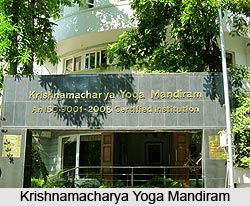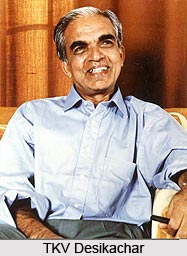 The Krishnamacharya Yoga Mandiram was established by TKV Desikachar in 1976. He was the son and student of T Krishnamacharya. The Krishnamacharya Yoga Mandiram is a reputed institute of yoga both nationally and internationally. The institute does not focus on making profit but it aims at spreading the message of yoga and the teachings of T Krishnamacharya. Since its inception the Krishnamacharya Yoga Mandiram(KYM) has always stood for the quality teaching and faith and respect of its students. It has always concentrated on the interests, abilities and secular faith of the pupil of Yoga.
The Krishnamacharya Yoga Mandiram was established by TKV Desikachar in 1976. He was the son and student of T Krishnamacharya. The Krishnamacharya Yoga Mandiram is a reputed institute of yoga both nationally and internationally. The institute does not focus on making profit but it aims at spreading the message of yoga and the teachings of T Krishnamacharya. Since its inception the Krishnamacharya Yoga Mandiram(KYM) has always stood for the quality teaching and faith and respect of its students. It has always concentrated on the interests, abilities and secular faith of the pupil of Yoga.
The Krishnamacharya Yoga Mandiram is a tribute of TKV Desikachar to his father. He started his career as an engineer but later was inspired by his father`s teachings and enrolled as his student in the 1960s. He studied with Krishnamacharya for over thirty years. Today TKV Desikachar is a renowned name in the world who earned fame and respect as a Yoga teacher. The Krishnamacharya Yoga Mandiram is a government recognized Public Charitable Trust. The KYM has played a significant role in popularizing Yoga as a holistic science and also emphasizes on Yoga that stems from a well-founded theoretical basis, rather than only mere exercises for physical fitness. The focus of Krishnamacharya Yoga Mandiram is to help an individual who wants to practice Yoga, for the specific personal needs and to help in getting multiple benefits.
The Krishnamacharya Yoga Mandiram was founded based on the teachings of Tirumalai Krishnamacharya, who was a legend as a yogi, healer, Vedic scholar, and linguist expert in Indian schools of thought, author and a researcher. He was born in 1888 in a remote Indian village and lived for over hundred years. T. Krishnamacharya was one of the greatest yogis of modern era. He revived Yoga in early twentieth century and made its practice popular to common people. As a result, today yoga has become inherent part of everyday life of millions of people over the world. Krishnamacharya preserved ancient wisdom and revived lost teachings of Yoga and developed and adapted Yoga practices that would offer health, mental clarity and spiritual growth of an individual.
Krishnamacharya`s knowledge of Yoga was so vast that he could teach each of the students differently. He refused to standardize the practice and teaching methodology of Yoga but created an understanding of Yoga in a broad spectrum for his students. Krishnamacharya integrated ancient teachings of Yoga and Indian philosophy with modern day requirements. Krishnamacharya created yoga practices those were accurate and powerful as well as practical and relevant.
Fernando Pages Ruiz summed up Krishnamacharya`s immense contribution to yoga in his article ` The Legacy of Krishnamacharya` in the proper way- "You may have never have heard of him, but Tirumalai Krishnamacharya influenced or perhaps even invented your yoga. Whether you practice the dynamic series of Pattabhi Jois, the refined alignments of BKS Iyengar, the classical postures of Indra Devi, or the customized vinyasa [of Desikachar], your practice stems from one source: a five-foot, two-inch Brahmin born more than one hundred years ago in a small south Indian Village."
The founder of Krishnamacharya Yoga Mandiram was TKV Desikachar, who was son and student of T Krishnamacharya and had the privilege of living and studying with his father and mentor from 1960 until Krishnamacharya`s death in 1989. Over forty-five years TKV Desikachar has dedicated his life for the teaching of Yoga and making it relevant to all kinds of people coming from different strata of society. Desikachar`s teaching method is based on Krishnamacharya`s fundamental principal that yoga must always be adapted to an individual`s changing needs for the purpose of deriving the maximum therapeutic benefit. Desikachar also had a degree in structural engineering besides his Yoga training. He is one of the world`s foremost Yoga teachers and a renowned authority of the therapeutic uses of Yoga. TKV Desikachar continued to look over KYM`s work in therapy as well as training and guiding the faculty of KYM.
The mission of Krishnamacharya Yoga Mandiram is to heal people through Yoga. Till today, Yoga therapy is the hallmark of KYM and it does not end with curing physical illness only. The Yoga therapy offers holistic healing to those who seeks relief from any problem, which can be anything from physical, mental, emotional or spiritual. Each person is taken care individually with the focus on dealing with the cause of the disease rather than treating with the symptoms of the problem.
 There is another separate wing of Krishnamacharya Yoga Mandiram named KYM Institute of Yoga Studies, which started in the year of 1988 with the objective of spreading the teachings of T Krishnamacharya. The objective is achieved through training programs, workshops and seminars and conferences, which discuss about wide variety of topics and themes. The courses are offered to Indians and international students. The KYM Institute of Yoga Studies conducts short-term courses for groups and individuals from different countries based on Yoga related topics. These courses are highly individualized and designed to suit the needs of visiting group or individual.
There is another separate wing of Krishnamacharya Yoga Mandiram named KYM Institute of Yoga Studies, which started in the year of 1988 with the objective of spreading the teachings of T Krishnamacharya. The objective is achieved through training programs, workshops and seminars and conferences, which discuss about wide variety of topics and themes. The courses are offered to Indians and international students. The KYM Institute of Yoga Studies conducts short-term courses for groups and individuals from different countries based on Yoga related topics. These courses are highly individualized and designed to suit the needs of visiting group or individual.
Intensive courses were initially offered to private groups from different parts of the world on their request. Since 1997, a one-month intensive course covering the broad spectrum of asana, pranayama and dhyana was formally conducted every year on November. But later there was huge demand to participate in this course and therefore this intensive course was offered twice a year from 2002 onwards. An advanced two-week residential retreat is being arranged once a year from 2002.
Apart from the programs offered by KYM Institute of Yoga Studies, they continue to organize and conduct programs for private groups on a vast range of themes upon request, besides offering classes to individual students who want to have private one-on-one lessons.
The Krishnamacharya Yoga Mandiram also emphasizes on Vedavani to carry forth an ancient oral tradition. Vedic Chanting is an ancient oral tradition of India that comes from several thousand years back. The Vedas are collection of hymns on a vast range of subjects that were created by the sages and they got them within their deepest meditation. The Vedas passed orally from generation to generation and were only chanted by few. T Krishnamacharya was first to throw light upon Vedic chanting and made it popular to those who were interested in preserving this year-old tradition. Krishnamacharya took Vedic Chanting as a universal tool for physical, mental, spiritual and emotional fulfillment and growth and thus Vedavani was incepted in the year 1999. Here Vedavani or Vedic chanting is taught to individuals and groups with the emphasis on following the rules and pedagogy of chanting the Vedas.
Yoga gradually became popular as the holistic system for health and healing. Millions of people across the world took up seriously. The KYM believes that if a difference can be made in the lives of those who genuinely need supports then Yoga is the only key factor that can change their lives. KYM-Mitra is an outreach program that touches the lives of the socially and economically unprivileged and differently able by the gift of Yoga.
There are also many researches conducted in the Krishnamacharya Yoga Mandiram. The researches include- rehabilitation of children who are mentally challenged, asana based exercises for the management of low back pain, Yoga Pranayama and Thermal Biofeedback techniques in the Management of stress and high blood pressure, efficacy of yoga therapy in the management of headaches, efficacy of yoga in the management of bronchial asthma, yoga for schizophrenia patients, yoga for the mentally ill, Better Health By Alternative Life Styles (BETHALS), an evaluation of Yoga as a therapy for certain ailments.




















